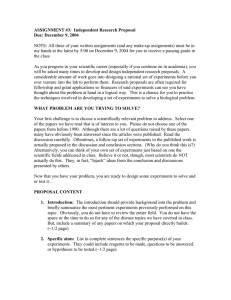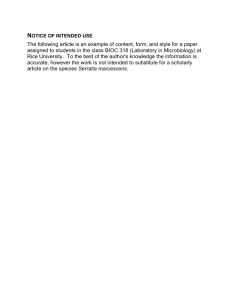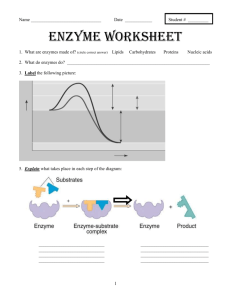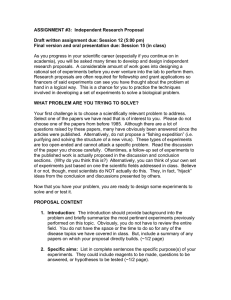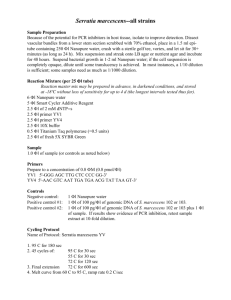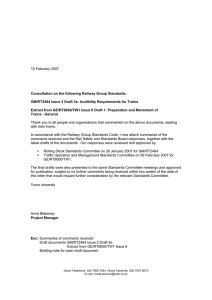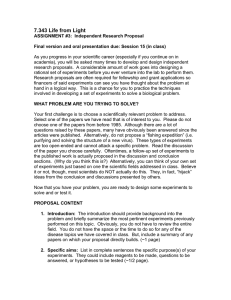International Research Journal of Biotechnology (ISSN: 2141-5153) Vol. 3(6) pp.... Available online
advertisement
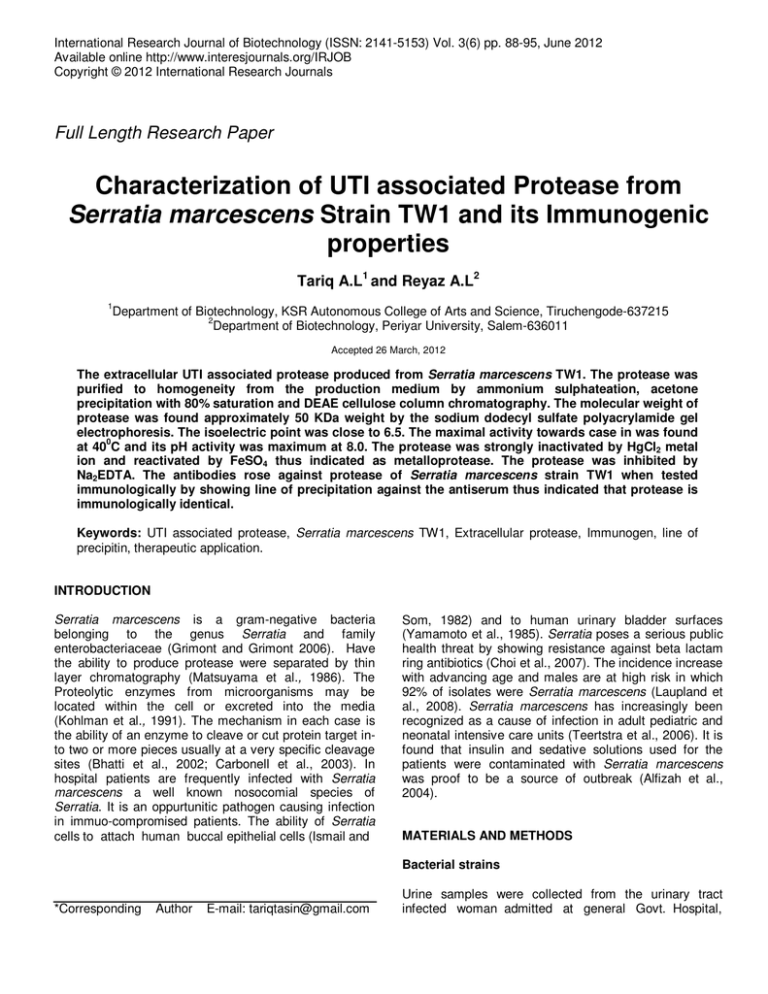
International Research Journal of Biotechnology (ISSN: 2141-5153) Vol. 3(6) pp. 88-95, June 2012 Available online http://www.interesjournals.org/IRJOB Copyright © 2012 International Research Journals Full Length Research Paper Characterization of UTI associated Protease from Serratia marcescens Strain TW1 and its Immunogenic properties Tariq A.L1 and Reyaz A.L2 1 Department of Biotechnology, KSR Autonomous College of Arts and Science, Tiruchengode-637215 2 Department of Biotechnology, Periyar University, Salem-636011 Accepted 26 March, 2012 The extracellular UTI associated protease produced from Serratia marcescens TW1. The protease was purified to homogeneity from the production medium by ammonium sulphateation, acetone precipitation with 80% saturation and DEAE cellulose column chromatography. The molecular weight of protease was found approximately 50 KDa weight by the sodium dodecyl sulfate polyacrylamide gel electrophoresis. The isoelectric point was close to 6.5. The maximal activity towards case in was found at 400C and its pH activity was maximum at 8.0. The protease was strongly inactivated by HgCl2 metal ion and reactivated by FeSO4 thus indicated as metalloprotease. The protease was inhibited by Na2EDTA. The antibodies rose against protease of Serratia marcescens strain TW1 when tested immunologically by showing line of precipitation against the antiserum thus indicated that protease is immunologically identical. Keywords: UTI associated protease, Serratia marcescens TW1, Extracellular protease, Immunogen, line of precipitin, therapeutic application. INTRODUCTION Serratia marcescens is a gram-negative bacteria belonging to the genus Serratia and family enterobacteriaceae (Grimont and Grimont 2006). Have the ability to produce protease were separated by thin layer chromatography (Matsuyama et al., 1986). The Proteolytic enzymes from microorganisms may be located within the cell or excreted into the media (Kohlman et al., 1991). The mechanism in each case is the ability of an enzyme to cleave or cut protein target into two or more pieces usually at a very specific cleavage sites (Bhatti et al., 2002; Carbonell et al., 2003). In hospital patients are frequently infected with Serratia marcescens a well known nosocomial species of Serratia. It is an oppurtunitic pathogen causing infection in immuo-compromised patients. The ability of Serratia cells to attach human buccal epithelial cells (Ismail and Som, 1982) and to human urinary bladder surfaces (Yamamoto et al., 1985). Serratia poses a serious public health threat by showing resistance against beta lactam ring antibiotics (Choi et al., 2007). The incidence increase with advancing age and males are at high risk in which 92% of isolates were Serratia marcescens (Laupland et al., 2008). Serratia marcescens has increasingly been recognized as a cause of infection in adult pediatric and neonatal intensive care units (Teertstra et al., 2006). It is found that insulin and sedative solutions used for the patients were contaminated with Serratia marcescens was proof to be a source of outbreak (Alfizah et al., 2004). MATERIALS AND METHODS Bacterial strains *Corresponding Author E-mail: tariqtasin@gmail.com Urine samples were collected from the urinary tract infected woman admitted at general Govt. Hospital, Tariq and Reyaz 89 Namakkal District in Tamil Nadu. The organism was isolated (Matsumato et al., 1984) by using Caprylatethallious agar medium. The urine samples were serially diluted and spread over the medium then incubated at 370C for 24 hours. The purification of the isolated potential proteolytic organism was done by following a method of Rifaat et al., (2007). The strain TW1 showed the highest proteolytic activity and identified by biochemical tests and 16S rDNA genomic sequence. Enzyme production The protease was produced by following a method of Salamone and Wodzinski (1997) using the enzyme production medium Tryptone-yeast extract glucose broth containing: Tryptone 5g/l, Yeast extract 2.5g/l, Glucose 1g/l and pH 7.2. For the study of protease production 250ml of medium was poured into 1000ml of Erlenmeyer flask capacity, and were sterilized at 1210C for 15 minutes. After cooling 0.5ml of stationary phase culture of strain TW1 was inoculated and incubated on shaker at 280C for 48 hours. was determined at 280nm. One unit of proteolytic was defined as the amount of enzyme that produced an increase of absorbance at 280nm of 0.1 under the conditions of the assay. Molecular weight determination by SDS-PAGE The molecular weight of the protein in strain TW1 was determined by the method of Laemmli et al., (1970) staining the protein with 10% methanol, 7% acetic acid and 0.2% coomassie brilliant blue for 4 hours and destained with 10% methanol, 25% acetic acid solution for 12 hours. Isoelectric focusing of protein The isoelecric focusing of purified protease of strain TW1 was determined using mini-gel system (Robertson et al., 1987). The gel was placed in staining solution for 30minutes and destained for one hour. The bands were observed in white light transilluminator. Enzyme purification Effect of temperature on protease activity The protease was purified by following method of Matsumato et al., (1984) from culture broth by centrifugation at 10000rpm for 20minutes at 40C. The supernatant was collected and filtered through membrane filter having porosity of 0.022µm at 40C then subjected to 80% ammonium sulphate and actone saturation. The pellet was obtained by centrifugation at 10000rpm for 20 minutes at 40C and resuspended in 20mM Tris HCl pH 8.0 then dialyzed against 500ml of 5mM Tris-HCl pH 8.0 containing 1mM MgCl2 over night at 40C with stirring conditions. The dialyzate was centrifuged at 8000rpm for 20 minutes at 40C and supernatant were subjected to DEAE-cellulose anion exchange column chromatography equilibrated with 10mM Tris-HCl buffer pH 8.3. The 15ml of dialysate eluted with 10mM Tris-HCl buffer pH 8.3 at the flow rate of 20ml/h. A linear gradient consisting of 50ml of 10mM Tris-HCl buffer pH 8.3 and 50ml of the same buffer with 0.3M NaCl. The 5ml of fractions elute were collected and absorbance measured at 280nm and enzyme activity was determined. 0.2ml protease sample of strain TW1 was added to the substrate mixture containing 1.5ml of 1.0% (w/v) casein in 100mM Tris-HCl in 1mM MgCl2 at pH 8.0 and incubated at 300C, 350C, 400C, 450C, 500C, 550C, 600C for one hour. After the incubation, the proteolytic activity was determined by the protease assay, an optical density was measured at 280nm. Effect of pH on protease activity 0.2ml protease sample of strain TW1 was added to the substrate mixture containing 1.5ml of 1% (w/v) casein, and 0.1mM MgCl2 in various buffers. Such as GlycineHCl buffer having pH 2.0, 2.5, 3.0, 3.5, Acetate buffer having pH 4.0, 4.5, 5.0, 5.5, phosphate buffer having pH 6.0, 6.5, 7.0, Tris- HCl buffer having pH 7.5, 8.0, 8.5, 9.0 and carbonate bicarbonate buffer having pH 9.5, 10.0, 10.5, 11.0 and incubated at 370C for 60 minutes. After incubation the proteolytic activity was determined by the protease assay. Determination of protein content and assay of proteolytic activity Effect of metal ions on protease activity The protein concentration of strain TW1 was determined by the method of Lowry et al., (1951) by taking bovine serum albumin as standard. The proteolytic activity was determined by following a method of Kunitz (1947) using casein as substrate and absorbance for the supernatant 0.2ml protease sample of strain TW1 was added to the 1.5ml of 0.1 M Tris-HCl pH 7.5 and to the same buffer supplemented with 100µl of 8.3mM of metal ions viz MgSO4, MnCl2, CaCl2, CuSO4, FeSO4, HgCl2 and ZnCl2 90 Int. Res. J. Biotechnol. Table 1. Biochemical identification of UTI associated bacterial strain Serratia marcescens TW1 S.No 1 2 3 4 5 6 7 8 9 10 11 12 13 14 Biochemical test Indole Methyl Red Voges Proskauer Citrate Triple sugar iron Hydrogen sulphide production Glucose Sucrose Sorbitol Fructose Xylose Rhaminose Lactose Arabinose Result N N P P A/K G-ive P F F F F NF NF N NF Where N-negative, P-positive, A/K – Acid/Alkaline, G-ve –gas negative, F- fermentation, NF- no fermentation and mixtures were incubated at temperature of 250C for 30mintues and proteolytic activity was determined by protease assay. In addition the purified protease sample preparation (200µl/ml) was incubated for 30 minutes at 250C in 0.1 M acetate buffer having pH 5.0 supplemented with (100µl/ml) Na2EDTA and protease activity was determined by protease assay. at 5000rpm for 15 minutes. The straw yellow colored serum was stored at 4oC in the presence of 0.1% sodium oxide as antibacterial agent. The antiserum was then tested by immunodiffusion for the formation of immunoprecipitate. Immunodiffusion by Ouchterlony method 0.2ml protease sample of strain TW1 preparation was added into 1.5ml of 0.1M tris-hydrochloride buffer having pH 7.5 and to the same buffer supplemented with 100µl of various inhibitors 20mM Na2EDTA, 8.3mM iodioacetic acid, 8.3mM dithiothreitol, 8.3mM leupeptin, 1% of 2 βmercaptoethanol, 1% of tween-20 and 3% of ethanol and mixtures were incubated at 250C for 30 minutes and proteolytic activity was determined by protease assay. The immunodiffusion analysis for the antiserum of protease strain TW1 was followed by method of Ouchterlony (1968) in a double diffusion technique both the antigen and antibody are allowed to diffuse into the gel and meet to each other. The antigen and antibody react to produce the antigen-antibody complex. At equilibrium the complex produced immobile and form a thin band of precipitin. The precipitin is visualized either directly or after protein staining for interpretation. Assessment of Therapeutic Role of Protease RESULT Effect of inhibitors on protease activity Bacterial soil isolate 0.2 ml of the protease samples of strain TW1 was emulsified with 0.8 ml of incomplete Freund’s adjuvant (Hum and Chantler, (1980) by vortaxing thoroughly. The emulsion was injected subcutaneously into Rabbit (NCP/IAEC /KSR/04 /2009) by using 21-gauge needle. Similarly three booster doses were given at intervals of 10 days following the initial injection. After the eight days of last booster dose the rabbit was bled at the marginal vein near in ear and 15ml of blood was collected and were allowed to clot for 3 to 4 hours at room temperature. The serum was separated from the clot by centrifugation After 48 hours of incubation it was found to be 1.25x103 CFU/ml in the Serratia medium ATCC from the urine sample. The total 205 strains were isolated from the urine samples of UTI infected women and the potential proteolytic strain TW1 was found gram negative rod shaped bacterium by biochemical tests are presented in Table 1. The 16s rDNA gene sequences confirmed that it belongs to Serratia marcescens therefore this bacterium was named as Serratia marcescens TW1 under Gene Bank ACC. No. GU046545. Tariq and Reyaz 91 Table 2. Purification of Protease from S. marcescens TW1 in the supernatants of tryptone yeast extract glucose medium. S. No 1 2 3 4 5 Purification Stage Cell free culture supernatant Ammonium sulfate fraction Acetone fraction Dialysate DEAE cellulose Fraction Volume (ml) Protein conc. (mg/ml) Total protein (mg) Activity (U/mg) Specific activity (U/mg) Total activity (U) Purification (-fold) Recovery (%) 2500 0.8 2000 799 998 1997500 1 100 200 3.9 780 6985 1791 1397000 1.8 90 50 100 5.7 0.5 285 50 23708 3590 4159 7180 1185400 359000 4.1 7.1 80 70 50 0.3 15 2532 8440 126600 8.5 50 Figure 1. Determination of molecular weight of proteases by sodium dodecyl sulphate agarose gel electrophoresis. L1—Molecular marker mass standards: phosphorylase b (97 kDa), tyrosine (85kDa), acid phosphate (75kDa), bovine serum albumin (66 kDa), glutamic dehydrogenase (50 kDa) and aldolase (40 kDa) L2—Protease sample of S. marcescens TW1 (50KDa) Enzyme purification The purification process showed that 80% ammonium sulphate saturation had precipitated the protease in the solution by salt out mechanism and recovered with 80% acetone saturation. After the dialysis the precipitated protease of Serratia marcescens strain TW1 got purified by the DEAE Cellulose anion exchanged chromatography with 10mM Tris HCl buffer pH 8.3 (Table 2). Determination of protein content and proteolytic activity of protease enzyme The proteolytic activity was 83.84 IU/ml in casein as substrate. The molecular weight of protease Serratia marcescens strain TW1 was found approximately 56 KDa protein band when observed under white transilluminator (Figure 1) and isoelectric point was 6.5 in an ampholyte buffer having pH ranges from 2.0 to 11.0 (Figure 2). Effect of temperature on protease activity The temperature optimum for the protease of Serratia marcescens TW1 was 400C in 100mM Tris HCl buffer as shown in Figure 3. The activity declined rapidly above 400C and was negligible above 550C. The enzyme 0 retained its 82% activity at 40 C when temperature increased the enzyme activity decreases rapidly and lost 0 at 60 C. Effect of pH on protease activity The pH optimum of protease Serratia marcescens strain 92 Int. Res. J. Biotechnol. Figure 2 . Isoelectric focusing electrophoretogram, pH 2.0 to 11.0 stained with coomassie blue. M—Isoelectric focusing standards: amyloglucosidase (pI 3.6), trypsin inhibitor (pI 4.5), carbonic anhydrase II (pI 6.5), lentil lectin (pI 8.3) and ribonuclease A (pI 9.6) L1 and L2—Serratia marcescens TW1 showing pI 6.5 90 Enzyme Activity IU/ml 80 70 60 50 40 30 20 10 0 25 30 35 40 45 50 55 60 65 Effect of Temperature in Degree Figure 3. Effect of Temperature on protease activity was examined in 100mM Tris-HCl buffer having pH 8.0 at 250 C, 300C, 350C, 400 C, 450C, 500 C, 550C, 600C and 650C for 30 minutes. The Serratia marcescens strain TW1 showed maximum activity at optimum 400 C . TW1 was 8.5 with a sharp decrease in activity above pH 9.0. The protease had half maximal activity near pH 7.5 and exhibited a little activity below pH. The protease retained its maximum activity from pH 6.5 to 9.0 (Figure 4). Effect of metal ions on protease activity The metal ions have altered the protease activity of Serratia marcescens strain TW1. The HgCl2 and Na2EDTA have inactivated the protease at both pH 8.5 and pH 6.5. The protease have retained maximum activity in FeSO4, MgSO4, ZnCl2 and minimum activity in MnCl2, CaCl2, CuSO4 and lost its activity in HgCl2 and Na2EDTA (Table 3). Effect of inhibitors on protease activity The protease of Serratia marcescens strain TW1 showed the resistance against the all inhibitors but lost its activity in 20mM EDTA (Table 4). Antiserum production Antibodies rose against protease of Serratia marcescens strain TW1 got confirmed by immunodiffusion precipitation; the protease of Serratia marcescens strain Tariq and Reyaz 93 Figure 4. Effect of pH on protease activity was examined in various buffers such as Glycine-HCl buffer having pH 2.0 to 3.5, Acetate buffer having pH 4.0 to 5.5, Phosphate buffer having pH 6.0 to7.0, Tris-HCl buffer having pH 7.5 to 9.0 and CarbonateBicarbonate buffer having pH 9.5 to 11.0. at 300C for 30 minutes. The pH optimum of Serratia marcescens strain TW1 was at pH 8.5 Tris-HCl buffer. Table 3. Effect of metal ions on protease activity was examined in 8.3mM of MgSO4, MnCl2, CaCl2, CuSO4, FeSO4, HgCl2 and ZnCl2 in 0.1M Tris-HCl buffer having pH 7.5 at 250 C for 30 minutes. The metal ions HgCl2 and 20mM Na2EDTA have inactivated the protease of Serratia marcescens TW1. S. No 1 2 3 4 5 6 7 8 9 Metal Ion Native protease FeSO4 MnCl2 CaCl2 CoSO4 ZnCl2 MgSO4 HgCl2 Na2EDTA Residual Protease Activity (%) 100 75 26 19 14 60 70 00 00 Table 4. Effect of inhibitors on protease activity was examined in 20mM EDTA, 8.3mM Iodioacetic acid, 8.3mM Dithiothreitol, 8.3mM Leupeptin, 1% of 2- β Mercaptoethanol, 1% of Tween 20 and 3% of ethanol in 0.1M Tris-HCl having pH 7.5 at 250C for 30 minutes. The protease of Seratia marcescens strain TW1 was inactivated completely by 20mM EDTA. S.No 1 2 3 4 5 6 7 8 Inhibitors Native protease Iodioacetic acid 2- Mercaptoethanol Tween 20 3% Ethanol Dithiothreitol Leupeptin 20mM EDTA Residual protease activity (%) 100 78 80 88 85 70 84 00 94 Int. Res. J. Biotechnol. Figure 5. Ouchterlony double immunodiffusion: The 1.2% (wt/vol) agarose gel was prepared in 0.05M borate buffer having pH 8.5. The distance form the peripheral wells to the centre well is approximately 5.5mm and each cut of well is 4mm in diameter, P—Centre well contained 20µl of antiserum, S1—Cultural broth supernatant of 20µl Serratia marcescens strain TW1, S2—Ammonium sulphate fraction 20µl Serratia marcescens strain TW1, S3—Dialysate protease 20µl Serratia marcescens strain TW1, S4—DEAE cellulose purified of 20µl Serratia marcescens strain TW1 TW1 showed line of precipitatin against the antiserum (Figure 5).Thus indicated that protease is immunologically identical. DISCUSSION The Serratia marcescens strain TWI secretes large extracellular enzyme protease in the surrounding medium (Yanagida et al., 1988). The production was stopped at early stationary phase at that time maximum protease was produced (Henriette et al., 1993). The 80% ammonium sulphate saturation leads the precipitation of 0 the protease at 4 C and fractional precipitation with acetone (Salamone and Wodzinski, 1997). The excess salt was removed from protease by means of a dialysis (Morita et al., 1997). The dialyzate of Serratia marcescens strain TW1 purified by ion exchange chromatography relied on the attraction between oppositely charged particles. The net charge exhibited by these compounds was depends on their pka and pH of the solution. The proteolytic activity was determined by using casein as substrate (Kunitz, 1947) in Tris HCl buffer pH 8.0 and showed the protease activity of 83.84 IU/ml. The purified exocellular protease turned out to be one polypeptide chain with a molecular weight of 56 KDa averages of the values obtained by SDS-PAGE (Laemmli, 1970). The isoelectric point of protease Serratia marcescens strain TW1 was 6.5 (Robertson et al., 1987). As proteins are differing in the composition each and every protein has its own characteristic pI value. The optimal temperature of protease Serratia marcescens strain TW1was 400C in Tris HCl buffer containing MgCl2 having pH 8.0. The protease activity lost when temperature was increased to 600C there was negligible activity. The pH characteristics of proteases Serratia marcescens strain TW1 showed high enzyme activity between 6.5 to 9.0 and maximum at 8.5 in Tris HCl buffer (Lyerly and Kreger, 1979). The metals ions HgCl2 and Na2EDTA completely inactivated the protease activity (Matsumoto et al., 1984) and reactivated by Mg2+, Fe2+, Zn2+ and Mn2+ are essential for the enzyme activity so named as metalloprotease (Aiyappa and Haris 1976). The 20mM EDTA inhibited the enzyme activity completely while as other inhibiters did not showed much impact on enzyme activity. The proteolytic enzymes offer a powerful treatment for pain and inflammation with widespread use in arthritis, fibrocystic breast disease, chronic bronchitis, sinusitis, atherosclerosis, wound debridement and carpal tunnel syndrome (Kee et al., 1989; Coulthrust et al., 2006; Lee et al., 2006). These produce pharmacological effects by absorption through the intestines into blood stream (Miyata, 1980). But oral bioavailability of these peptide drugs is generally very low, owing to acidic conditions of the stomach and poor permeability across intestinal mucosa (Rawat et al., 2006). The proteolytic enzymes and protease inhibitors have shown invitro capacity to depress or inhibit some fundamental activity of bacteria (Grenier, 1992). Sarratiopeptidase has been widely used in therapy as an anti-inflammatory drug because of its ability to enhance the penetration of antibiotics in infected cells (Coria- Tariq and Reyaz 95 Jimenez et., 2004). Serratia peptidase was effective for eradicating infection caused by biofilm forming bacteria (Mecikoglu et al., 2006). REFERENCES Alfizah H, Nordiah AJ, Rozaidi WS (2004). Using plused-field gel electrophoresis in the molecular investigation of an out break of Serratia marcescens in intensive care unit. Singapore Med. J. Infection. 45(5): 214-218. Bhatti AR, Alvi A, Walia S, Chaudhry GR (2002). Ph dependent modulation of alkaline phosphatase Activity in Serratia marcescens. Current Microbiology. 45: 245-249. Carbonell GV, Amorim CRN, Furumura MT, Darini ALC, Fonseca BAL, Yano T (2003). Biological activity of Serratia marcescens cytotoxins. Brazillian J. Medical Biological Res. 36: 351-359. Choi HS, Lee JE, Park SJ, Kim NM, Choo EJ, Kwak YG, Jeong JY, Woo JH, Kim NJ, Kim YS (2007). Prevalence, microbiology and clinical characteristics of extended-spectrum β-lactamase producing Enterobacter spp., Serratia marcescens, Citrobacter freundii and Morganella morganii in Korea. Eur. J. Clinical Microbial Infect. Dis. 26: 557-561. Coria-Jimenez R, Zarate-Aquino C, Ponce-Ponce O (2004). Proteolytic activity in Serratia marcescens clinical isolates. Folia Microbial. 49(3):321-326. Coulthrust SJ, Williamson NR, Harris AKP, Spring DR, and Salmond GPC (2006). etabolic and regulatory engineering of Serratia marcescens: mimicking phage mediated horizontal acquisition and antibiotic biosynthesis and quorumsensing capacities. Journal of Microbiology.152: 1899-1911. Grenier D (1992). Effect of protease inhibitors on in vitro growth of Porphyromonas gingvalis. Microb. Ecol. Health Dis. 5: 133 -38. Grimont F, Grimont PAD (2006). The Genus Serratia. Prokaryotes. 6:219-244. Hum BAL, Chanther SM (1980). Production of Reagent Antibodies. In: Methods in Enzymology. 70 (Eds. van vunakis, H and langone JJ). Aeademic press, New york P. 104. Ismail G, Som FM (1982). Hemagglutination reaction and epithelial cell adherence activity of Serratia marcescens. Journal of Gen. Appl. Microbiol.28: 161-168. Kee WH, Tan SL, Lee V, Salmon YM (1989). The treatment of breast engorgement. With serrapeptase (Danzen): a randomised double blind controlled trail. Singapore Med Journal. 30(1): 48 – 54. Kohlmann KL, Nielsen SS, Steenson LR, Ladisch MR (1991). Production of protease by psychrotrophic micro organisms. Journal of Dairy Science.74: 3275-3283. Kunitz M (1974). Crystalline soybean trypsin inhibitor.II.General properties. J. Gen. Physiol. 30:291-297. Laemmli UK (1970). Clearage of structural proteins during the assembly of the head of bacteriophage. T. Nature 227:680– 685. Laupland KB, Parkins MD, Gregon DB, Church DL, Ross T, Pitout JD (2008). Population based laboratory surveillance for Serratia species isolates in a large Canadian health region. Eur. J. Clin. Mirobiol. Infect. Disease. 27: 89-95. Lee WI, Jaing TH, Hsieh MY, Kuo ML, Lin SJ, Huang JL (2006). Distribution, infections, Treatments and molecular analysis in a large cohort of patients with primary immuno deficiency Diseases (PIDS) in Taiwan. J. Clinical Immunol. 26(3): 274-283. Lowry OH, Rosebrough NJ, Farr AL, Randall RJ (1951).Protein measurement with the Folin phenol reagent. J. Biol. Chem.193:265275. Lyerly D, Kreger A (1979). Purification and characterization of a Serratia marcescens metalloprotease. Infection and Immunity. 24(2):411-421. Matsumoto K, Maeda H, Takata K, Kamata R, Okamura R (1984). Purification and characterization of four proteases from clinical isolates of Serratia marcescens kums 3958. J. Bacteriol. 157(11): 225-232. Matsuyama T, Murakami T, Fujita M, Fujita S, Yano I (1986). Extracellular vesicle formation and biosurfactant production by Serratia marcescens. Journal of General Microbiology.132:865-875. Mecikoglu M, Saygi B, Yildirim Y, KaradagSaygi E, Ramadan SS, Esemenli T (2006). The effect of proteolytic enzyme serratiopeptidase in the treatment of experimental implant-related infection. The J. Bone and Joint Surgery (American). 88: 1208-1214. Miyata K (1980). Intestinal absorption of Serratia peptidase. Journal App Biochem. 2:111-116. Ouchterlony O (1968). Hand book of immuno-diffusion and immunoelectrophoresis. Ann Arbor Science Publication, Michigan. Rawat M, Saraf S, Saraf S (2007). Influence of selected formulation variables on the preparation of enzyme- entrapped eudragit S100 microspheres. AAPS Phama Sci Tech. Article 116, 8 (4):289-297. Rifaat HM, Said OHE, Hassanein SM, Selim MSM (2007). Protease activity of some mesophilic Streptomycetes isolated from Egyptian habitats. Journal of Culture Collection. 5:16-24. Robertson EF, Dannelly HK, Malloy PJ, Reeves HC (1987). Rapid isoelectric focusing in a vertical polyacrylamide mini gel system. Anal Biochem. 167:290-294 Salamone PR, Wodzinski RJ (1997). Production, purification and characterization of a 50-KDa extracellular metalloprotease from Serratia marcescens. Appl Microbiol Biotechnology. 48: 317-324. Teertstra TK, Bergman KA, Benno CA, Albers MJ (2006). Serratia marcescens septicemia presenting as purpura fulminans in a premature newborn. Eur J. Clinical Microbial Infect. Dis. 24: 846-847. Yamamoto T, Ariyoshi A, Amako K (1985). Fimbriamediated adherence of Serratia marcescens strain US5 to human urinary bladder surface. Microbiol Immunol. 29:677-681. Yanagida N, Uozumi T, Beppu T (1986). Specific excretion of Serratia marcescens protease through the outer membrane of Escherichia coli. J. Bacteriol. 166: 937-944.
